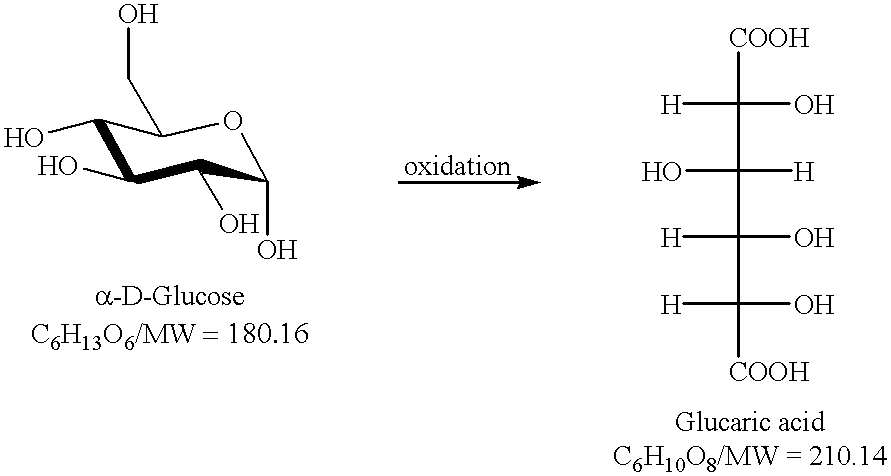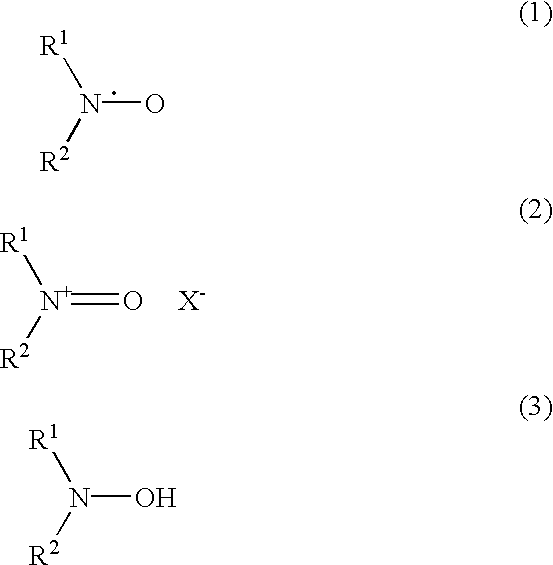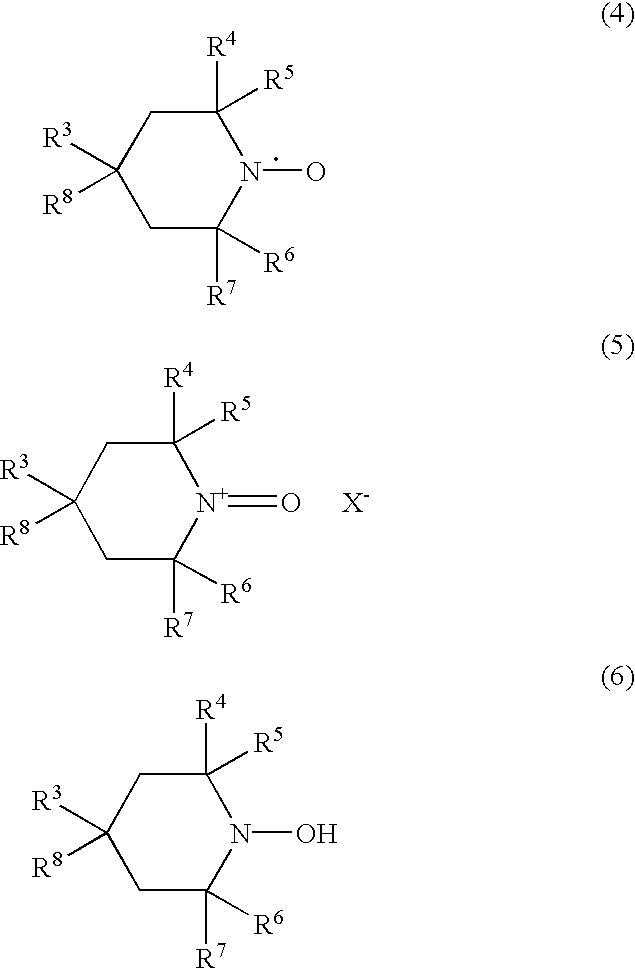Method for the oxidation of aldehydes, hemiacetals and primary alcohols
- Summary
- Abstract
- Description
- Claims
- Application Information
AI Technical Summary
Benefits of technology
Problems solved by technology
Method used
Image
Examples
example 1
Conversion of Glucose to Monopotassium Glucarate
To an aqueous solution (50 mL) of glucose (3 g) is added KBr (400 mg), a nitroxide catalyst (4-acetylamino-2,2,6,6-tetramethylpiperidine-1-oxy, 40 mg) and an aqueous KOH solution (6.51 g in 30 mL water). The solution is chilled to 0C and gaseous chlorine is bubbled through a glass frit into the solution at a rate so not to allow the temperature of the stirred solution to rise over 5.degree. C. The pH of the solution is held constant at 11.5 through addition of a 2 molar solution of KOH by an autotitrator. Reaction progress is followed by .sup.13 C NMR. Once the signal indicative of the primary alcohol group in glucose had disappeared (about 63 ppm, D.sub.2 O, 25.degree. C.), the addition of chlorine is stopped and the solution is flushed with nitrogen. Concentrated HCl is added to the chilled solution until pH 3.4 is reached. The precipitated monopotassium glucarate is isolated by filtration through a glass-fritted funnel. The mother l...
example 2
Conversion of Glucose to Disodium Glucarate
To an aqueous solution (50 mL) of glucose (3 g) is added NaBr (400 mg), nitroxide catalyst (4-acetylamino-2,2,6,6-tetrarnethylpiperidine-1-oxy, 40 mg) and an aqueous NaOH solution (4.4 g in 30 mL water). The solution is chilled to 0.degree. C. and gaseous chlorine is bubbled through a glass frit into the solution at a rate so not to allow the temperature of the stirred solution to rise over 5.degree. C. The pH of the solution is held constant at 11.5 through addition of a 2 molar solution of NaOH by means of an autotitrator. Reaction progress is followed by .sup.13 C NMR. Once the signal indicative of the primary alcohol group in glucose had disappeared (about 63 ppm, D.sub.2 O, 25.degree. C.), the addition of chlorine is stopped and the solution is flushed with nitrogen. The pH is adjusted to 8.0 by adding 1 molar aqueous HCl. The solution is then concentrated to about 30 mL, and the disodium glucarate is precipitated by addition of ethano...
example 3
Conversion of Galactose to Mucic Acid
To an aqueous solution (50 mL) of galactose (3 g) is added KBr (400 mg), nitroxide catalyst (4-acetylamino-2,2,6,6-tetramethylpiperidine-1-oxy, 40 mg) and an aqueous KOH solution (6.51 g in 30 mL water). The solution is chilled to 0.degree. C. and gaseous chlorine is bubbled through a glass frit into the solution at a rate so not to allow the temperature of the stirred solution to rise over 5.degree. C. The pH of the solution is held constant at 11.5 through addition of a 2molar solution of KOH by means of an autotitrator. Reaction progress is followed by .sup.13 C NMR. Once the signal indicative of the primary alcohol group in galactose had disappeared (.about.63 ppm, D.sub.2 O, 25.degree. C.), the addition of chlorine is stopped and the solution is flushed with nitrogen. Concentrated HCl is added to the chilled solution until pH 1.5-2.0 is reached. The precipitated mucic acid is isolated by filtration through a glass-fritted fimnel. The yield o...
PUM
| Property | Measurement | Unit |
|---|---|---|
| Fraction | aaaaa | aaaaa |
| Angle | aaaaa | aaaaa |
| Angle | aaaaa | aaaaa |
Abstract
Description
Claims
Application Information
 Login to View More
Login to View More - R&D
- Intellectual Property
- Life Sciences
- Materials
- Tech Scout
- Unparalleled Data Quality
- Higher Quality Content
- 60% Fewer Hallucinations
Browse by: Latest US Patents, China's latest patents, Technical Efficacy Thesaurus, Application Domain, Technology Topic, Popular Technical Reports.
© 2025 PatSnap. All rights reserved.Legal|Privacy policy|Modern Slavery Act Transparency Statement|Sitemap|About US| Contact US: help@patsnap.com



